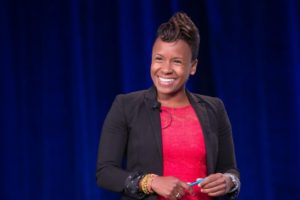
Stephanie Lampkin, Founder-CEO Blendoor
Technology and diversity are not synonymous. But that is not to say that African-Americans and people of color are not making efforts and having success in the cyber realm.
Black people have a saying; “Step out on faith.” That means you believe in yourself and a higher power to succeed. These sistahs have knowledge and talent and have stepped out into the tech industry with new and powerful ideas that can change the world. Black women are breaking the mold and shattering stereotypes by making a difference in the tech industry.
One of the biggest problems in the technology industry, and industry in general, is racial prejudice. It is common for people with so called “black sounding” names to be passed over for employment opportunities. One black woman has decided to fight back.
Stephanie Lampkin launched Blendoor to fight racial bias in hiring practices. Blendoor was one of the winning companies at Google Demo Day. Lampkin’s company also won Tech.Co’s Startup of the Year competition in 2015. Blendoor is a recruiting application that shields the prospective job candidate’s name, picture and dates to help curtail racial bias in hiring. Blendoor is focused on providing candidates to companies based on “merits not molds.”
“It’s quantifiable,” said Lampkin. “We realized that hiding names and photos created a safer space. Women and people of color felt better sharing their information.”
Racial bias in hiring has tools. Ethnic sounding names and faces of color are often rejected and using the well traveled professional networks can be an obstacle.
Lampkin believes women, people of color, members of the LGBT community and other minorities in Silicon Valley feel alienated by job search websites that reveal a candidates name and headshot.
Lampkin told Forbes.com; “I know a number of really successful, Ivy League-educated, African-American people between 35 and 45 who refuse to use LinkedIn out of fear of discrimination. These companies are founded by white guys. There’s a psychology I understand as a woman of color that’s driven how and why I’ve shaped the product the way I have.”
Lampkin 31, is an amazing story. She was born into a welfare household and her mother was at one time homeless while pregnant with her. Yet Lampkin over came incredible odds to become the CEO of a technology start up. She learned how to write code by the time she was 13 then went on to graduate from Stanford and MIT and worked for five years at Microsoft.
But Lampkin learned that was not enough. She was still ignored for jobs at major technology companies. As a black woman, Lampkin admits it was probably because she “did not look the part.” She just didn’t fit the mold of what tech companies are looking for. Deliberate or not it is commonly known as pattern matching. Lampkin states that often veterans and disabled people are also sifted out of the candidate pool.
Lampkin remembers advancing deep into the interview process for a prized job at a well-known tech firm in Silicon Valley. In the end she was told her background wasn’t “technical enough” for a role in software engineering.
“The recruiter told me a sales or marketing job might open up,” said Lampkin. She landed at Microsoft where she spent the next five years. Lampkin is nobody’s fool and understands that being a black women was not an asset in the tech industry. Repeated job rejections have taught her that.
Blendoor is not a one way street for companies looking to improve diversity in its ranks. Job candidates can also use the app to examine a company’s inclusion programs and diversity of its executive staff.
The app will also collect data on who is applying to tech’s most sought-after positions and who is getting them. “Blendoor wants to make companies accountable using data,” Lampkin said.
Now you know.
